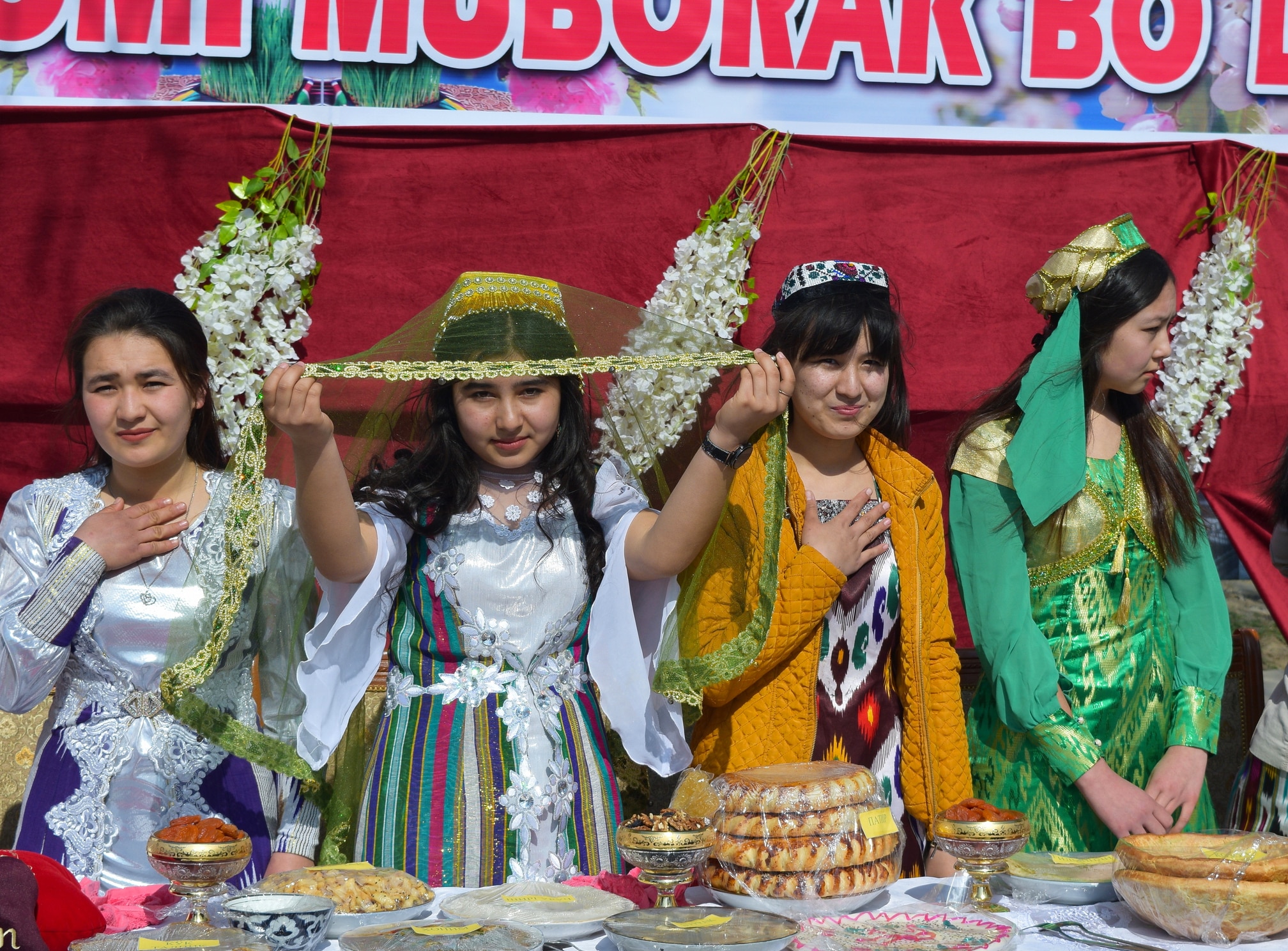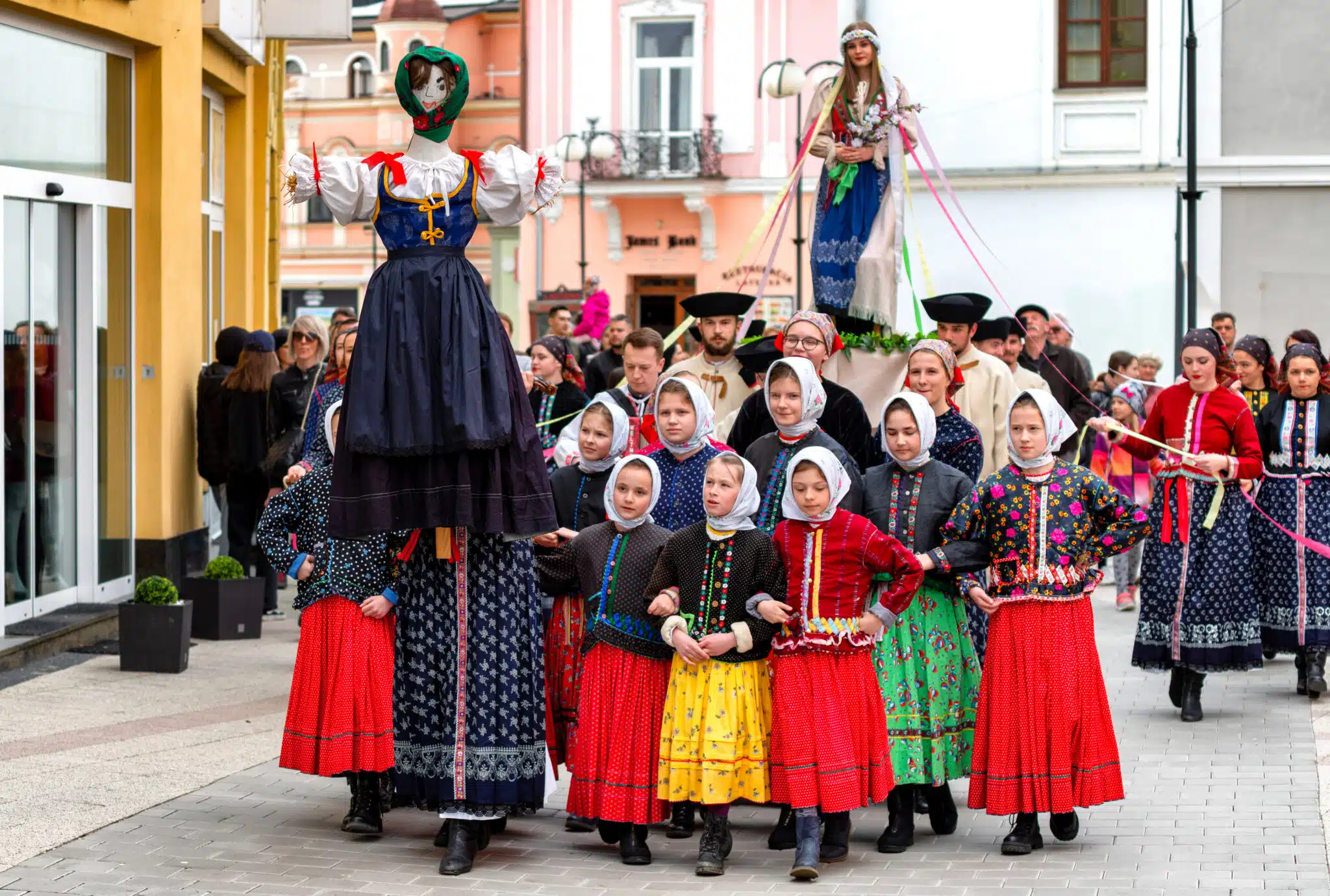Rites of welcoming spring and saying goodbye to winter are some of the oldest holidays preserved across Slavic cultures. In the Baltics, the celebrations were nearly lost after being suppressed by Catholic and imperial dominance. Today, Russia’s Maslenitsa is by the far the best-known, but multiple versions exist across the diverse Slavic landscape. In the Baltics, the holidays are seeing a revival as ways to express now-independent national cultures. Amazingly, even in societies that are now deeply Christian, all of these holidays are still celebrated in unabashedly pagan ways.
This article will briefly introduce you to four versions of the holiday and how they compare and contrast with each other: Russian Maslenitsa, Ukraine’s Masliana (Kolodii), Poland’s Marzanna, and Latvia’s Meteņi.
Russian Maslenitsa
Maslenitsa (Масленица) is the oldest surviving Russian holiday; archeological evidence suggests it may have been celebrated as early as the 2nd century A.D.
The holiday for Russians remains a loud and boisterous one. Associated with fertility and rebirth, feats of strength and competition are held such as public boxing and pole climbing.
While today Maslenitsa is more a celebration of tradition itself, the holiday originally revolved around gods and agricultural powers. The main god of the celebration, according to most accounts, was Veles (also known as Volos or Chernobog), a god of cattle, the earth, and the underworld. Maslenitsa was thus as much a recognition of the power of death as it was a celebration of rebirth and life.
The main food eaten was the blin, a thin pancake which could be eaten with a range of fillings including sweet and savory, but meat was forbidden. In fact, linguistic evidence suggests that name Maslenitsa (“Butter-Week”) was formally called “Myasopusta” (“meatless,” though the word form is now archaic).
This forgoing of meat was done not only in thanksgiving, but also as a method of purification as Russian culture has long regarded eating too much meat as a source of lust and violence.
Meanwhile, the round, golden blin symbolized the sun, which was ruled by Dazhbog, the god of life and abundance.
Maslentisa was a threshold time between the reigns of two gods, between death and life. Both forces were to be paid respect on this day – with a farewell to one and welcoming of the other. As it was a threshold time, it was a time when rules could be broken; in addition to gorging themselves on blini, people often wore masks and clothing of the opposite gender, role-played, consumed large amounts of alcohol, and generally made merry.
An effigy, often called “Lady Maslentitsa,” is still erected at start and burned at the end of the celebrations. Originally, the doll was seen as the personification of the holiday and its focus on the powers of fertility. Burning the doll was seen as the destruction of spent fertility and, carrying her ashes to the fields was planting the beginnings of a new season of growth.
Maslenitsa developed into a highly elaborate, multi-day festival. There was a day specifically for sharing blini with your sweetheart, a day to give blini to the poor, and a day when mothers-in-law cooked blini for their son’s wives. The last day of Maslentisa was “Forgiveness Sunday,” a day when debts and grudges were to be forgiven so that life could begin anew. Almost no one recognizes these special days today, although city festivals and cooking blini even at home will often extend for much of the week.
For much more on how Maslenitsa is celebrated in contemporary times, see this collection of student observations from SRAS students!
Ukraine’s Masliana (Kolodii)
Ukrainian ethnologists argue that traditions of Masliana likely extend back all the way to Trypillian culture, one of the world’s oldest settled civilizations. The Trypillians existed, in part, in what is now Western Ukraine from 5500 to 2750 BC.
Many Ukrainians prefer to call their holiday Kolodii, which is significant in multiple ways. The main god of the holiday was Koliada, the god of solar cycles who ensures that each season passes to the next. For this holiday, he was personified by a small log, known as the koloda. This log would be tied to the legs of unmarried youths to “shame” them for having not yet passed the cycle of life to the next generation.
Married women would also adopt a koloda who symbolically “lived” for the week. The women were obliged to entertain the god during this time, which often involved taking it to pubs and leaving the husbands at home to care for the house. This type of gender reversal was fairly common in ancient threshold holidays. As the week progressed, the koloda would die and would be buried in the fields and mourned.
Rites honoring the goddess Makrosh were also associated with this holiday. Makrosh was the supreme goddess of the earth with power over life and to protect from death. She ruled over the fields in which the koloda would be buried. By her power would the fields bear fruit in the spring.
Vareniki stuffed with farmer’s cheese were the main food for this holiday. The filled dumpling was meant to be representative of a womb and its fertility. Its half-circle shape was also meant to recall the moon, believed to be the feminine counterpart to the masculine sun. The holiday was heavily endowed with lunar symbolism in celebration of the feminine power to spawn life.
Ukraine’s Masliana also evolved to have seven distinct days. Each day came with a different stage in the life of the Koloda (ie birth, death, burial, mourning). Each day also had a specifically responsibility to one’s friends and family, culminating in Forgiveness Sunday when debts and grudges were to be forgiven so the that life could begin anew with a fresh start. Ukrainians still recognize and actively practice this last day.
In Soviet times, the traditions of Maslinitsa and Masliana began to merge, with blini taking over vareniki in Ukraine and sun symbolism taking over lunar, for instance. Many Ukrainians regard this as impositions on their native customs, driven by authorities who planned to Russify the Ukrainians. Today, while these elements can still generally be found in modern Masliana celebrations, there is a strong social movement to emphasize older, more Ukrainian elements to the holiday – including the name.
Poland’s Marzanna
Examining the Polish tradition is somewhat more complex, as there are in fact two holidays to now consider.
The first is Fat Thursday, a day which roughly corresponds to Mardi Gras and is recognized to have some pagan history. Today, however, Fat Thursday is mostly simply a day on which one eats many Polish filled donuts and most of the historical paganism is forgotten.
There is one legend of Fat Thursday from southern Poland, however, that is of particular interest. There, it is said, in one town, there was a mayor who would mistreat women in the marketplace. When he died, on Fat Thursday, it became a day of celebration on which the women would dance, eat, and accost passing men and demand from them offerings to apologize for the harm the former mayor had inflicted.
Here, although it has been made very specific and secular, we can see shades of Koloda and Maslenitsa in the legend – a celebration of death during the rebirth of spring as well as an empowerment of women for the day.
The second, and perhaps even more relevant holiday is Marzanna. The holiday is named for the Marzanna, a goddess of winter, frost, death, and agriculture. Her yearly death ushers in the warmer weather and agricultural season. To mark the occasion, effigies of the goddess are made and carried through town. They are then either burned or drowned. The process carries considerable folklore and superstition, with many saying that once the doll is thrown into a river, one must turn one’s back on it and not look back. If one does, bad luck or sickness awaits.
The second part of the celebration is to gather green branches, decorate them, and carry them home. In some parts of Poland, this would be combined with caroling – taking the branches from house to house to bring cheer and often receive edible rewards.
Latvia’s Meteņi
Meteņi marks the end of winter and the beginning of spring in Latvia. It was calculated originally to fall at the midpoint between the winter solstice and the spring equinox, as the ancient Latvians used a solar calendar to coordinate their agricultural cycles. The holiday was meant to prepare the people and the land spiritually for another round of spring planting and, hopefully, another bountiful harvest.
The personification of the holiday is Meteņis, a god or spirit believed to be connected to the growth of flax and the fertility and productivity of domesticated animals, two of the main agricultural products of the ancient Latvians.
Much of ancient Latvian history has been preserved in dainas, which are short, simple songs about nearly everything. They are still sung by Latvians today. In the dainas of Metenis, he is known to have five sons and five daughters and would arrive to the festival on a magic sleigh. The course of his sleigh would determine the coming year’s fertility. This eventually translated to the concept of distance being central to the holiday: swinging higher, sledding father, and traveling great distances to visit friends and relatives became central to the holiday and ways to ensure the year’s agricultural success.
Meteņis also features, as most Latvian celebrations do, feasting, song, and dance. The feast focuses on pork and, in particular, pig’s feet, head, snout, ears, and sausage, as well as breads, rolls, beer, and other grain-based dishes.
A dish called grūdenis, a porridge made from pork, barley grits, and potatoes, and sometimes with beans and grey peas added as well, was often a focal point of the meal. Pig’s head meat was the most prized for the pork element of the dish – because meat from the head is unusually fatty and tender.
Families gathered for the feast after a day of sledding and other outdoor physical recreation. Songs would often accompany the recreation and meal, focusing on dainas, the simple songs that represented the main transmitter and repository of Latvian culture and history in pre-literate times.
Evening festivities included singing, dancing, and the arrival of ķekatas, revelers known for their rowdy, uninvited visits. Ķekatas wore grotesque disguises depicting animals, people, or spirits to hide their identities, a tradition common to many season-turning traditions across Europe. Going house to house, the ķekatas sang songs that both praised and teased the hosts, inspected homes for cleanliness, and playfully demanded food and drink. Sometimes they stole small items, a tolerated tradition symbolizing winter hardship. Often, these items would turn up again, hidden in an unexpected location, symbolizing the luck the year might bring.
Though not as widely observed today, it is making something of a comeback as Latvians look to revive their ancient traditions as an expression of Latvianness. Every year, one can find multiple celebrations, most often held in smaller towns and cities. These draw tourists, both foreign and Latvian, from Latvia’s larger cities who come seeing a a way to connect with the wider country and its long history. For many, it feels like a way of celebrating Latvia’s still relatively new sovereignty, as Latvia spent most of the medieval and modern ages under imperial domination, which often sought to tamp down traditions like Meteni. It is also, much like it was, a way to celebrate the end of a long, cold, dark winter and find joy in the eagerly anticipated longer, sunnier days ahead.
The Persistence of Spring Holidays
In each of these holidays, we see a respectful farewell to death and winter and a jubilant welcoming of spring and life. We can see the temporary embodiment of a god or a natural force which then dies and/or is destroyed. Through this death, life is seen as renewed.
All of these holidays faced stiff resistance from Christian leadership after the arrival of Christianity to their respective countries. In all three countries, however, the holidays persisted virtually unchanged. In most cases, the holidays simply became accepted acts of revelry before the advent of Lent, with its weeks-long fast. Marzanna, celebrated later on the spring equinox, simply persisted.
All of these holidays also survived Communist authorities who initially tried to ban them as part of a broader anti-religious policies. However, in all cases the holidays were allowed to officially resurface after political thaws and especially in the 80s, when Maslenitsa and Masliana even became nation-building efforts under the Soviets and large state-sponsored festivals were held.
These are not the only similar holidays within the area of Central and Eastern Europe. While each is unique in its own way, we can see some similarities in the ancient festivals that survive in places as diverse as Slovakia, Bulgaria, and Latvia.
While the holidays have generally lost their refrences to pagan gods, they have kept their pagan traditions and imagery. Today, they are celebrated to express pride of tradition and, often, pride in one’s national identity. That the holidays have survived so long and withstood so many attempts to oppress them makes them all the more powerful as expressions of personal and national resilience.
You’ll Also Love

Latvia’s Līgo: A Midsummer Tradition That Outlived Empires
Līgo is the most important of Latvia’s national holidays. Marking the summer solstice and rooted in pre-Christian pagan traditions, it began as an ancient ritual to secure a good harvest and help communities endure the long, harsh Lativan winter. Despite centuries of foreign occupation and efforts by both Catholic and Soviet authorities to suppress it, […]

Wigilia: Polish Christmas Eve as a Reflection of History and National Identity
By the end of November, the cold cobblestone streets in Polish villages and cities are lined with Christmas markets selling traditional Polish cuisine, handcrafted souvenirs, and traditional amber handicrafts. Christmas is one of Poland’s largest celebrations. The main festivities occur over the course of three days from December 24 to 26. The 25th and 26th […]

Sabantuy: A Global Summer Festival Celebrating Tatar Heritage
Sabantuy (Сабантуй) is the traditional Volga (Kazan) Tatar summer festival. It dates back to pre-Islamic, pagan times and originally was a ritual that asked the gods for a plentiful harvest. Today, however, the festival can best be understood as a national Tatar celebration of their culture and traditions. Sabantuy are inclusive, community-building events. In Tatarstan, […]

Navruz, Nooruz, Nowruz: The Ancient Spring New Year of Central Asia
Navruz is a spring solstice celebration that marks the beginning of the New Year according to the traditional Persian calendar. It has been a beloved holiday for some 3,000 years, surviving cultural change caused by centuries of tumultuous history. It was once celebrated on the vernal equinox but is now celebrated on the set date […]

Yhyakh: A Summer New Year in the Coldest Place on Earth
The original Sakha is given for some terms in parentheses. Photographs provided by Mitrofan kyyha Varvara Egorova-Dygyia, Susan Crate, and Kathryn Yegorov-Crate. Yhyakh (ыһыах) is the Sakha people’s annual summer festival during which Sakha make offerings to sky deities known as aiyy (айыы) and make merry before the laborious hay-cutting season. Yhyakh is often rendered […]













